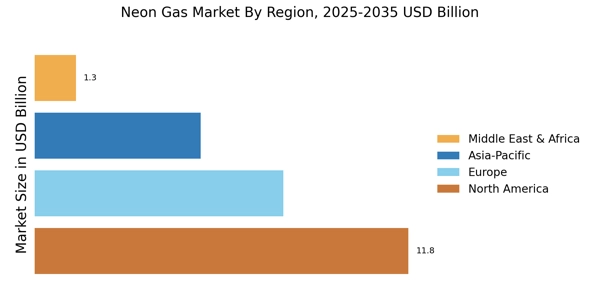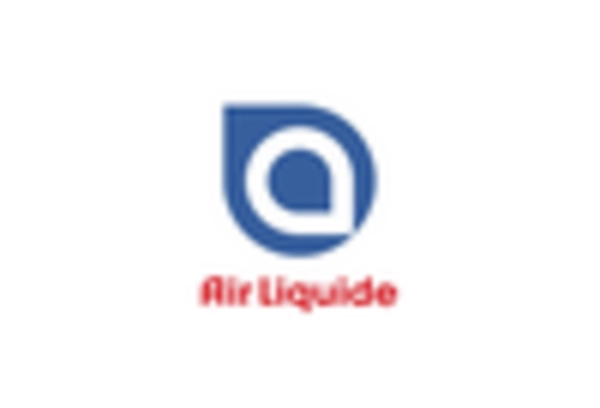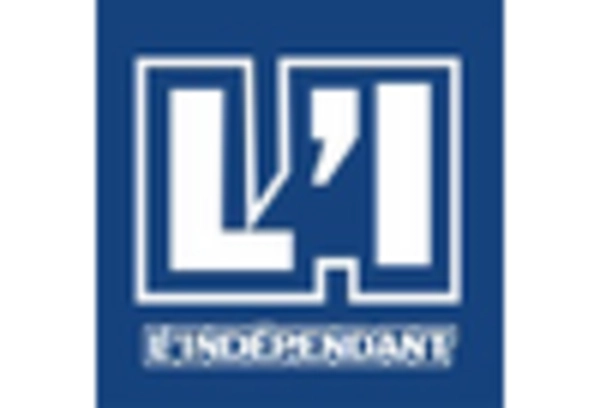Rising Applications in Laser Technology
The Neon Gas Market is witnessing a notable increase in applications within laser technology. Neon gas is a critical component in various types of lasers, including those used in medical and industrial applications. The demand for laser systems is projected to grow, driven by advancements in healthcare and manufacturing sectors. As of 2025, the laser technology market is expected to expand at a compound annual growth rate of around 6%, which directly influences the neon gas demand. This trend indicates a robust correlation between the growth of laser applications and the Neon Gas Market. Manufacturers are likely to capitalize on this opportunity by enhancing their production capabilities to meet the specific needs of laser technology, thereby fostering further growth in the industry.
Regulatory Support for Clean Technologies
The Neon Gas Market is benefiting from increasing regulatory support for clean technologies. Governments are implementing policies that promote the use of noble gases, including neon, in various applications due to their low environmental impact. As industries strive to comply with stricter environmental regulations, the demand for neon gas is expected to rise. Current trends suggest that the market could see a growth rate of around 3% annually as companies seek to adopt cleaner technologies. This regulatory environment not only fosters innovation within the Neon Gas Market but also encourages collaboration between manufacturers and regulatory bodies to develop sustainable practices. Such initiatives are likely to enhance the overall market landscape, positioning neon gas as a preferred choice in environmentally conscious applications.
Growing Interest in Neon Lighting Applications
The Neon Gas Market is experiencing a revival in interest for neon lighting applications, particularly in decorative and architectural lighting. Neon lights are favored for their vibrant colors and energy efficiency, making them a popular choice for signage and artistic displays. As of 2025, the market for neon lighting is projected to grow at a rate of 4% annually, driven by trends in urban development and nightlife culture. This resurgence in neon lighting applications not only boosts the demand for neon gas but also encourages innovation in lighting design. Manufacturers in the Neon Gas Market are likely to explore new applications and designs, thereby expanding their market reach and enhancing product offerings to cater to this growing segment.
Increased Demand from the Semiconductor Industry
The Neon Gas Market is significantly impacted by the burgeoning semiconductor industry. Neon gas is essential for the production of photolithography equipment, which is crucial in semiconductor manufacturing. As the demand for semiconductors continues to rise, driven by the proliferation of electronic devices and the Internet of Things, the need for neon gas is expected to follow suit. Current estimates indicate that the semiconductor market could grow by approximately 7% annually, thereby creating a substantial demand for neon gas. This relationship underscores the importance of the Neon Gas Market in supporting technological advancements in electronics. Suppliers are likely to focus on securing stable sources of neon gas to meet the increasing requirements of semiconductor manufacturers, ensuring a steady supply chain.
Technological Innovations in Neon Gas Production
The Neon Gas Market is experiencing a surge in technological innovations that enhance production efficiency. Advanced methods such as cryogenic distillation and gas separation techniques are being adopted, leading to higher purity levels and reduced production costs. As of 2025, the production capacity of neon gas has increased significantly, with estimates suggesting a growth rate of approximately 5% annually. This technological evolution not only meets the rising demand but also positions manufacturers to respond swiftly to market fluctuations. Furthermore, the integration of automation in production processes is likely to streamline operations, thereby improving overall productivity. Such advancements are crucial for maintaining competitiveness in the Neon Gas Market, as they enable suppliers to offer high-quality products at competitive prices.


















Leave a Comment